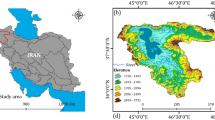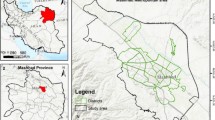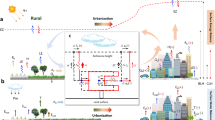Abstract
Global water resources are vulnerable to depletion due to the increasing demand of an ever-increasing human population. A country’s water footprint is a measure of the total volume of water needed to produce the goods and services consumed by the country, including water originating beyond its own borders. The water footprint can be a critical indicator of global water resource use, but its practical application is hindered by a lack of comparable data across national boundaries. The purpose of this article is to test the applicability of the nighttime imagery products produced by the Defense Meteorological Satellite Program’s Operational Linescan System (DMSP-OLS) for the assessment of the global water footprint. To accomplish this purpose, the average areal extent of nighttime lighting (lit area) is calculated from 1997 to 2001. Next, lit area is regressed on the total water footprint for each country, as indicated by the Water Footprint Network (WFN), to estimate that country’s total water footprint using nighttime imagery. Model residuals are analyzed at the national scale to understand the appropriateness of nighttime imagery for assessing water consumption. Results indicate strong positive correlations between lit area and total water footprint (TWF), domestic water withdrawal (DWW), and industrial water consumption (IWC) at the national scale. Overall, the analyses reveal that the rate of agricultural water consumption to total water footprint (AWCR) and population density can affect the precision of estimates when lit area is selected as a proxy to estimate water footprints.
Similar content being viewed by others
References
Amaral S, Camara G, Monteiro AMV, Quintanilha JA, Elvidge CD (2005) Estimating population and energy consumption in Brazilian Amazonia using DMSP night-time satellite data. Comput Environ Urban Syst 29:179–195
Chapagain AK, Orr S (2009) An improved water footprint methodology linking global consumption to local water resources: a case of Spanish tomatoes. J Environ Manag 90:1219–1228
Denko DM (1992) The digital chart of the world project. Photogramm Eng Remote Sensing 58:1125–1128
Doll CNH, Muller JP, Elvidge CD (2000) Night-time imagery as a tool for global mapping of socio-economic parameters and greenhouse gas emissions. Ambio 29:157–162
Elvidge CD, Baugh KE, Kihn EA, Kroehl HW, Davis ER, Davis C (1997a) Relation between satellite observed visible-near infrared emissions, population, economic activity and electric power consumption. Int J Remote Sens 18:1373–1379
Elvidge CD, Baugh KE, Kihn EA, Kroehl HW, Davis ER (1997b) Mapping of city lights using DMSP Operational Linescan System data. Photogramm Eng Remote Sensing 63:727–734
Elvidge CD, Baugh KE, Dietz JB, Bland T, Sutton PC, Kroehl HW (1999) Radiance calibration of DMSP-OLS low-light imaging data of human settlements. Remote Sens Environ 68:77–88
Elvidge CD, Sutton PC, Ghosh T, Tuttle BT, Baugh KE, Bhaduri B, Bright E (2009) A global poverty map derived from satellite data. Comput Geosci 35:1652–1660
Harris JA, Hobbs RJ, Higgs E, Aronson J (2006) Ecological restoration and global climate change. Restor Ecol 14:170–176
Hoekstra AY (2002) In: Virtual water trade: proceedings of the international expert meeting on virtual water trade. Value of Water Research Report Series No. 12, The Netherlands. http://www.waterfootprint.org/Reports/Report12.pdf. Accessed 4 March 2009
Hoekstra AY, Chapagain AK (2007) Water footprints of nations: water use by people as a function of their consumption pattern. Water Resour Manag 21:35–48
Imhoff ML, Lawrence WT, Elvidge C, Paul T, Levine E, Prevalsky M, Brown V (1997) Using nighttime DMSP/OLS images of city lights to estimate the impact of urban land use on soil resources in the U.S. Remote Sens Environ 59:105–117
Jenerette GD, Wu W, Goldsmith S, Marussich WA, Roach WJ (2006) Contrasting water footprints of cities in China and the United State. Ecol Econ 57:346–358
Lo CP (2002) Urban indicators of China from radiance-calibrated digital DMSP/OLS nighttime Images. Ann Assoc Am Geogr 92:225–240
Moser SC, Luers AL (2008) Managing climate risks in California: the need to engage resource managers for successful adaptation to change. Clim Change 87(Suppl 1):S309–S322
Oak Ridge National Laboratory (2010) LandScan Frequently Asked Questions, Why can’t I get the previous versions of the LandScan Global Population Datasets? http://www.ornl.gov/sci/landscan/landscan_faq.shtml#07. Accessed 6 September 2010
Pahl-Wostl C, Mostert E, Tabara D (2008) The growing importance of social learning in water resources management and sustainability science. Ecol Soc 13:24
Rees WE (1992) Ecological footprints and appropriate carrying capacity: what urban economics leaves out. Environ Urban 4:121–130
Rockstrom J, Lannerstad M, Falkenmark M (2006) Assessing the water challenge of a new green revolution in developing countries. PNAS 104:6253–6260
Small C, Pozzi F, Elvidge CD (2005) Spatial analysis of global urban extent from DMSP-OLS night lights. Remote Sens Environ 96:277–291
Smith JB (1997) Setting priorities for adapting to climate change. Glob Environ Change 7:251–264
Sutton PC, Elvidge CD, Ghosh T (2007) Estimation of gross domestic product at sub-national scales using nighttime satellite imagery. Int J Ecol Econ Stat 8:5–21
Sutton PC, Roberts D, Elvidge CD, Baugh K (2001) Census from heaven: an estimate of the global human population using night-time satellite imagery. Int J Remote Sens 22:3061–3076
Sutton P, Roberts C, Elvidge C, Meij H (1997) A comparison of nighttime satellite imagery and population density for the continental united states. Photogramm Eng Remote Sensing 63:1303–1313
United Nations Statistics Division (2007) Demographic Yearbook—Table 3: population by sex, rate of population increase, surface area and density. http://unstats.un.org/unsd/demographic/products/dyb/dyb2007/Table03.pdf. Accessed 1 March 2010
Vorosmarty CJ, Green P, Salisbury J, Lammers RB (2000) Global water resources: vulnerability from climate change and population growth. Science 289:284–288
Wackernagel M, Rees WE (1996) Our ecological footprint: reducing human impact on the Earth. New Society Publishers, Gabriola Island
World Bank (2010) World Development Indicators dataset. http://data.worldbank.org/data-catalog. Accessed 6 September 2010
Author information
Authors and Affiliations
Corresponding author
Rights and permissions
About this article
Cite this article
Zhao, N., Ghosh, T., Currit, N.A. et al. Relationships Between Satellite Observed Lit Area and Water Footprints. Water Resour Manage 25, 2241–2250 (2011). https://doi.org/10.1007/s11269-011-9804-3
Received:
Accepted:
Published:
Issue Date:
DOI: https://doi.org/10.1007/s11269-011-9804-3




